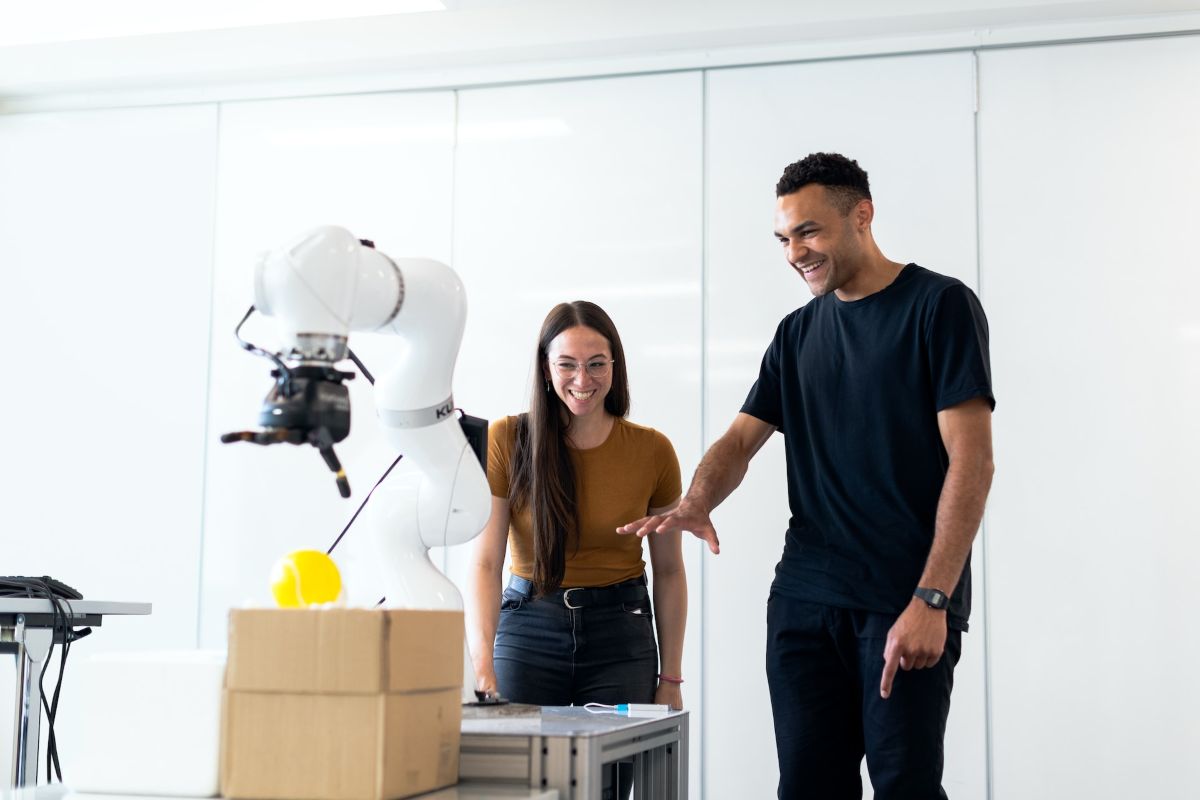The integration of robotics in our rapidly evolving world has sparked a revolution that is reshaping various aspects of our lives.
Robotics is revolutionizing our interaction with technology across various industries, including manufacturing, healthcare, space exploration, and even our homes. This article explores the fundamental concepts of building and programming robots, allowing enthusiasts to delve into this thrilling field.
Let’s explore the fundamental concepts in the field of robotics, focusing specifically on automation and tasks.
Introduction to Robotics Revolution

The Robotics Revolution signifies a significant era where robots, intelligent machines with the ability to independently perform tasks, have become essential in numerous aspects of our lives. Advancements in technology, such as sensors, artificial intelligence, and computing power, are driving this revolution.
The use of robots has brought about a revolution in industries such as manufacturing, as they are able to perform tasks with exceptional precision and speed. They perform tasks such as assembling products, welding components, and packaging goods, which helps to improve production efficiency and minimize errors.
This not only results in cost savings but also enhances product quality and consistency. The Robotics Revolution represents a significant change in our approach to tasks, ranging from everyday chores to intricate industrial processes. Robots are more than mere tools; they serve as partners in advancing progress, enhancing human capabilities, and expanding the limits of what can be accomplished.
With the continuous evolution of technology, the role of robots will continue to expand. This expansion will lead us into a future where collaboration between humans and robots will shape a new era of innovation and advancement.
Basic Concepts in Robotics
Following are some of the basic concepts of Robotics, let’s have a look:
Automation and Tasks
- One way to boost efficiency is through automation, which involves the use of robots to perform tasks that were previously done by humans. This results in enhanced efficiency since robots can work continuously without the need for breaks.
- Robots are highly skilled at performing repetitive tasks that can be monotonous or physically challenging for humans.
- Robots are capable of performing tasks with a high level of precision, which helps to maintain consistency in their output and minimise errors.
- These systems are designed to handle intricate tasks that demand a level of precision beyond what humans are capable of, such as the assembly of complex components.
Sensors and Actuators
- Sensors are devices that provide robots with information about their environment. They are designed to sense and gather data from the surroundings. If you don’t know much about them, you can get help from the best machine learning bootcamps. Some examples of sensors include cameras, ultrasonic sensors, infrared sensors, and touch sensors.
- Sensors play a crucial role in enabling robots to perceive their environment by detecting objects, obstacles, light, temperature, sound, and various other factors. This perception serves as a guiding force for their actions and decisions.
- Actuators are mechanisms that enable robots to interact with their surroundings. Common actuators include motors, servos, and pneumatic systems.
- Actuators play a crucial role in facilitating physical interaction for robots. They allow robots to move, pick up objects, manipulate tools, and perform various tasks by utilising the data collected from sensors.
- Industrial robots are a type of robot that is specifically designed and used for industrial applications. These robots are typically used in manufacturing and production processes to automate tasks such as assembly, welding, painting, and material handling.
- Industrial robots are known for their precision, speed, and efficiency, and they are often used to improve productivity and reduce human labour in industrial settings.
Types of Robots (Industrial, Service, Educational)
- Robots are utilised in various industries for a range of tasks including welding, painting, assembly, and packaging.
- These devices are specifically designed to prioritise precision, speed, and repeatability, ultimately improving both production efficiency and product quality.
- Collaborative industrial robots, also known as cobots, are equipped with safety features that allow them to work alongside humans in a secure manner, ultimately enhancing productivity.
- Service robots are a type of robots that are designed to perform various tasks and provide assistance to humans. These robots are programmed to carry out
- Human Assistance robots are specifically designed to provide support and aid to humans in a wide range of settings, including healthcare, hospitality, and customer service.
- Service robots are capable of performing a wide range of tasks, including guiding visitors, cleaning, delivering items, and even providing companionship.
- Service robots are commonly equipped with advanced sensors and artificial intelligence (AI) capabilities, which enable them to effectively navigate complex environments and engage in interactions with individuals.
- Educational robots are a type of technology that is designed to enhance learning experiences.
- Educational robots are specifically designed to teach and inspire students about the fields of robotics and programming.
- These kits allow students to assemble and program robots, offering a practical way to grasp the principles of robotics.
- These robots play a crucial role in promoting learning in the fields of science, technology, engineering, and mathematics, thereby fostering the development of future innovators.
Understanding these concepts is crucial for grasping the significant role that robotics plays in revolutionizing industries, improving efficiency, and facilitating collaboration between humans and robots.
By understanding automation, the interaction between sensors and actuators, and the various types of robots, individuals can gain valuable insights into the complex realm of robotics and its significant influence on contemporary society.
How to Build Your First Robot?
Learn how to build your very own first ever robot.
Choosing a Robot Kit or Designing from Scratch
- Robot Kit: Beginners can start with robot kits that provide pre-selected components and assembly instructions. Kits are designed to teach while building, making the process educational and fun.
- Designing from Scratch: Advanced users can design robots tailored to specific needs. This involves selecting components, creating mechanical designs, and ensuring compatibility.
Required Components
- Microcontroller: The brain of the robot, responsible for processing data and controlling actuators based on programming.
- Chassis: The physical framework of the robot that houses all components and determines its structure.
- Motors and Wheels: These enable movement. Motors are controlled by the microcontroller to achieve desired motion.
- Power Supply: Provides energy to all components. Battery packs or rechargeable batteries are commonly used.
- Sensors: Depending on the robot’s purpose, sensors gather information about the environment or the robot’s internal state.
- Actuators: These components physically interact with the world based on the robot’s programming.
Step-by-Step Assembly Guide
- Prepare the Workspace: Gather tools and ensure a clean, organized workspace.
- Assemble the Chassis: Follow the kit’s instructions or your design to build the robot’s physical structure.
- Attach Motors and Wheels: Securely attach motors and wheels to the chassis. These enable movement.
- Connect Electronics: Attach the microcontroller, sensors, and other components according to the wiring diagram.
- Power Supply: Connect and test the power supply. Ensure proper voltage and polarity.
- Write Your First Robot Program: Use the chosen programming language to write a simple program for your robot’s basic movements.
- Test and Refine: Run the program and observe the robot’s behavior. Make adjustments as needed.
Troubleshooting Common Assembly Issues
- Loose Connections: Check all connections to ensure they are secure.
- Software Errors: Debug the code for syntax or logic errors.
- Power Problems: Ensure the power supply is stable and providing the correct voltage.
- Sensor Calibration: Calibrate sensors if they’re not providing accurate data.
- Mechanical Constraints: Ensure moving parts have enough clearance and are not obstructed.
How to Program Your Robot
Are you aware of the benefits of Machine Learning vs AI? Most people don’t know what both of these entail. When you are trying to program your robot, these help a lot:
Write Your First Robot Program
- Programming Languages: Common languages for robotics include Python, C/C++, and Scratch. Choose one that matches your skill level and robot’s microcontroller.
- Basic Movements: Start with simple commands to make the robot move forward, backward, turn, and stop.
- Code Structure: Understand the structure of your chosen programming language (functions, loops, conditionals) to build more complex behaviors.
Implementing Basic Autonomous Behavior
- Sensor Integration: Use sensor data to make decisions. For example, program the robot to stop when it detects an obstacle.
- Decision Logic: Use if-else statements to define robot behavior based on sensor inputs.
- Loops: Implement loops to create repetitive actions or continuous monitoring of the environment.
Remote Control and Wireless Communication
- Wireless Modules: Integrate wireless modules like Bluetooth or Wi-Fi to control the robot remotely.
- User Interface: Develop a simple interface on a smartphone or computer to send commands to the robot wirelessly.
- Real-time Feedback: Set up the system to receive feedback from the robot’s sensors, enhancing remote control precision.
Conclusion
The field of robotics is constantly growing due to advancements in technology and the development of innovative applications. Some of the current trends in robotics involve the increasing popularity of collaborative robots (cobots) that can work together with humans.
Additionally, there have been significant advancements in artificial intelligence, allowing robots to acquire knowledge and adjust their behaviour accordingly. Industries can experience numerous advantages by incorporating robotics, including improved productivity, cost reduction, and enhanced safety measures.
In today’s society, we are witnessing the increasing presence of robots in various sectors such as healthcare, eldercare, education, and disaster response. As you begin your journey in robotics, it’s important to keep in mind that every small step you take will contribute to your understanding and expertise.
Robotics nurtures the development of critical thinking, problem-solving skills, and creativity. Embrace the challenges, celebrate the successes, and keep exploring the limitless possibilities that the robotics revolution offers.
Read Also:
- How Robots Can Change Workplace Culture
- 9 Ways To Use Technology In Your Business Growth Strategy
- COVID-19 Pushing Investors into Logistics Robotics
Author: Olivia Jane
















